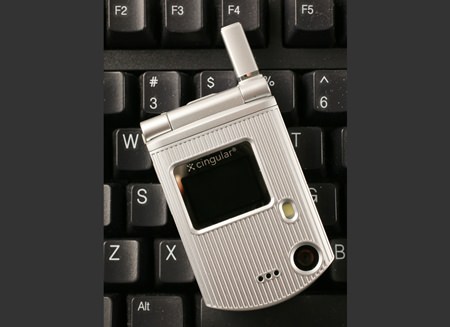New York (AP) – Between splashy launches, lavish new-phone offers (get a free HDTV on activation!) and frequent software updates that slow down your old handset, it sometimes feels like the entire technology industry is pushing you to buy the latest smartphone. Yet some holdouts resist.
Take Zak Sommerfield, 35, a software analyst in New York, who has hung onto his LG Delight flip phone for five years, even though his friends and co-workers make fun of it. “I hate smartphones, I hate how they take over people’s lives and they spend all their time looking at them,” he says. “I’d love to stay on this phone forever.”
 A C3 flip phone from Pantech is shown, on a keyboard for size comparison, in New York. More than 90 percent of smartphone users trade up for newer models within two years, according to experts. But a fraction of the population continues to cling to older phones, some 3 to 4 years old, or more. (AP Photo/Mark Lennihan, File)
A C3 flip phone from Pantech is shown, on a keyboard for size comparison, in New York. More than 90 percent of smartphone users trade up for newer models within two years, according to experts. But a fraction of the population continues to cling to older phones, some 3 to 4 years old, or more. (AP Photo/Mark Lennihan, File)
People like Sommerfield are a rarity. More than 90 percent of smartphone users trade up for newer models within two years, says Ramon Llamas, who tracks mobile phones at research firm IDC. But a fraction of the population continues to cling to older phones, some 3 to 4 years old – or more.
These upgrade holdouts have different reasons for standing athwart techno-progress, yelling “Stop!” Some reject the trend toward ever-larger screens, preferring smaller phones that are harder to find these days. Others simply aren’t wowed by the latest features, or see no reason to spend hundreds of dollars when their current phones still work fine.
“Just as we saw with PCs and tablets, lifetimes on people’s devices are generally getting a bit longer,” says Bob O’Donnell, chief analyst at Technalysis Research.
Every customer counts these days. Overall smartphone sales are slowing down – particularly in industrialized markets such as the U.S., where most people who want a smartphone already have one. IDC forecasts a 10 percent increase in worldwide smartphone sales this year, but that’s slowed considerably from 27 percent growth in 2014.
Some manufacturers have turned to emerging markets for new sales, but many customers there can afford only cheaper – and less profitable – devices. To keep making money on premium phones, Apple, Samsung and their rivals are counting on regular upgrades.
With its latest iPhones, Apple started an annual upgrade program that leases customers the latest models for a year. Upgrades are particularly important for Apple because iPhones account for more than half of its revenue.
Sprint and T-Mobile also have leasing options aimed at yearly iPhone upgrades, but Apple’s new leasing option has put even more pressure on carriers. They depend on regular upgrades to keep existing customers and sell them more services, such as bigger data plans or cloud services and storage. Since a customer upgrades only once every two or three years, it’s an “important moment to capitalize on” for carriers, says FBR analyst Daniel Ives.
To encourage upgrades, manufacturers have been packing new phones with cutting-edge hardware. The latest iPhones have better cameras and screen sensors to enable shortcuts and other menus with a hard press. Samsung won critical acclaim for curved screens that spill over a phone’s edges like a glassy waterfall.
Phones also get new system software every year, and many apps require the latest updates. Although many older phones can get the latest versions of Google’s Android or Apple’s iOS software, the updates can slow them down, and the phones sometimes don’t support all the new features.
Not surprisingly, Sprint CEO Marcelo Claure argues that having the latest model is important to many people. Phones are “the most valued personal possession that we have,” Claure said in an interview. “We use our phone to capture the memories of our lives.”
But O’Donnell of Technalysis says smartphone technology is “hitting the top of a curve.” As a result, each new model brings tweaks and refinements rather than new must-have features.
“I think it’s a little ridiculous to give up a perfectly good phone for a new one that is only slightly different,” says Kelsey Scott, 25, from Hutchinson, Kansas, who has an iPhone 5S from 2013 and doesn’t plan to upgrade.
And while many people upgraded last year when Apple made larger-size iPhones for the first time, matching what Samsung has long had, others prefer smaller phones. Apple still sells the 4-inch iPhone 5S, but the technology is two years old. The latest, fastest iPhones measure 4.7 inches and 5.5 inches diagonally.
Nathan Jarus, 24, says he’s been keeping his eyes open for inexpensive phones with 4-inch screens, but complains that “almost nobody seems to be making them.” The computer science PhD candidate from outside Rolla, Missouri, still uses Google’s discontinued 3.7-inch Nexus One phone from 2010.
Brett Shoemaker, 22, from Hattiesburg, Mississippi, a regular upgrader since the original iPhone debuted in 2007 – but stopped in his tracks with the 4-inch iPhone 5 in 2012.
Manufacturers are “forcing users into larger screen sizes for the latest and greatest technology” he says. “I’m contemplating not upgrading ever.” Or even switching to a BlackBerry, he adds, only half-joking.
High-end phones start at $200, a subsidized price that requires a two-year service contract. More recently, though, wireless companies have been pushing people to pay full retail price – often around $650 – via monthly installment plans. Although such deals also offer discounts on voice, text and data service, many people just see that they are paying more for the phone.
John O’Neill, 49, a tax analyst in Dallas, says he won’t upgrade from his iPhone 4, which he has had for nearly 5 years – mostly because he doesn’t want to lose his $30 unlimited data plan with Verizon. “I’ve looked around and nothing comes close,” he said.
For Mary Reichard, 52, legal affairs reporter in Springfield, Missouri, the money and fear of the unknown that keeps her from upgrading from her iPhone 4s she has had for two years.
“I long for the old days of one land line and tiny monthly bills,” she said. She also fears she might lose data if she upgrades. “I’m a baby boomer, so technology is still kind of scary.”
And some just feel too attached to their current smartphone to give it up. William Hurst, a 22-year-old student in Portland, Oregon, said he decided not to upgrade because he feels attached to his 3-year-old iPhone 5. He even likes its quirks like a lock screen button that doesn’t fully work and a crack from when he dropped it on cement in his rush to get in line for a concert.
“I have lived two years of my life with this same iPhone and it’s a part of who I am,” he said.




